Search results for 'omer'
-
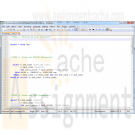
DBM 449 Lab 6 SQL Analytical Extensions and Materialized Views
$20.00For the lab this week we are going to look at how the ROLLUP and CUBE extensions available in SQL can be used to create query result sets that have more than one dimension to them. Both of these extensions are used in conjunction with the GROUP BY clause and allow for a much more broad look at the data.
The first thing you will do for this lab is download the lab6_create.sql file and run the file in your database instance. This file will log into the DBM449_USER and then create and populate a set of tables that will be used for this lab. Instructions for this are outlined in Step 1.
To record your work for this lab use the LAB6_Report.doc found in Doc Sharing. As in your previous labs you will need to copy/paste your SQL statements and results from SQL*Plus into this document. This will be the main document you submit to the Dropbox for Week 6.
LAB STEPS
STEP 1: Setting up Your Instance
For this lab you will be using a different user and set of tables than you have used so far for other labs. To set up your instance you will need to do the following.
- Download the lab6_create.sql file associated with the link to either the C drive on your computer or the F drive in your Citrix account.
- Open up the file and edit the login information at the top for the new user that is being created. You will need to replace the @ORACLE piece with the specifics for your instance name. DO NOT include AS SYSDBA after the name of your instance for this login.
- Now log into your instance as the SYS user. Run the script. The script is too long to copy/paste it into your SQL*Plus session so you should run the script using the @ sign from the SQL> prompt.
- Once the script has finished running then issue a SELECT * FROM TAB; sql statement. The result set will have tables from other labs as well but you want to make sure that you see the following tables listed.
TNAME TABTYPE CLUSTERID
------------------------------ ------- ----------
SUPPLIER TABLE
PRODUCT TABLE
DISTRICT TABLE
CUSTOMER TABLE
TIME TABLE
SALES TABLESTEP 2: Using the ROLLUP Extension
In this section of the lab you are going to create a sales report that will show a supplier code, product code and the total sales for each product based on unit price times a quantity. More importantly the column that shows the total sales will also show a grand total for the supplier as well as a grand total over all (this will be the last row of data shown). To do this you will use the ROLLUP extension as part of the GROUP BY clause in the query. Use aliases for the column names so that the output columns in the result set look like the following.
SUPPLIER CODE PRODUCT TOTAL SALES
------------- ---------- -----------For this report you are going to use the SALES, PRODUCT and SUPPLIER tables. You should be able to write your query using NATURAL JOIN but if you feel more comfortable using a traditional JOIN method that will work just as well. When finished you should have a total of 16 rows in your report and the grand total amount should show 2810.74.
Be sure to copy your SQL code and the result set produced and paste it into the appropriate place in the LAB6_REPORT.
STEP 3: Using the CUBE Extension
In this section of the lab you are going to create a sales report that will show a month code, product code and the total sales for each product based on unit price times a quantity. In this report the column that shows the total sales will also show a subtotal for each month (in this case representing a quarter) . Following the monthly totals for each product and the subtotal by month then the report will list a total for each product sold during the period with a grand total for all sales during the period (this will be the last row of data shown). To do this you will use the CUBE extension as part of the GROUP BY clause in the query. Use aliases for the column names so that the output columns in the result set look like the following.
MONTH PRODUCT TOTAL SALES
---------- ---------- -----------For this report you are going to use the SALES, PRODUCT and TIME tables. You should be able to write your query using NATURAL JOIN but if you feel more comfortable using a traditional JOIN method that will work just as well. When finished you should have a grand total amount of 2810.74 (same total as in the step 2).
Be sure to copy your SQL code and the result set produced and paste it into the appropriate place in the LAB6_REPORT.
STEP 4: Materialized Views and View Logs
Materialized views, sometimes referred to as snapshots are a very important aspect of dealing with data when doing data mining or working with a data warehouse. Unlike regular views, a materialized view does not always automatically react to changes made in the base tables of the view. To help keep track of changes made to the base tables you must create what is call a Materialized View Log on each base table that will be used in the view. In this step of the lab we will do this.
For the Materialized View we are going to create we are going to use the TIME and the SALES tables. Before we can create the view you will need to create a Materialized View Log on each of these two tables that will keep track of the ROWID and Sequence and include new values that have been added to the base table.
Be sure to copy your SQL code and the result set produced and paste it into the appropriate place in the LAB6_REPORT.
STEP 5: Creating and Using the Materialized View
Now that we have our logs created we can progress on to the view itself. For this part of the lab you are going to create a Materialized View, demonstrate that the view works, insert a row of data into one of the base tables and then update the view. Finally, you will show that the new data is in the view. The following steps will help move you through this process.
- First, write the SQL CREATE statement that will create a Materialized View based on the following:
- Name the view SALESBYMONTH.
- Include clauses that will build the view immediately, completely refresh the view, and enable a query rewrite.
- For the columns of the view you want to show the YEAR, MONTH, PRODUCT CODE, a TOTAL SALES UNITS, and a TOTAL SALES.
- You will want to group the columns by year, month and product code respectively.
- Execute your script to create the view and then issue a SELECT * FROM SALESBYMONTH.
The output columns from your view should look similar to the following (use aliases to format the column headings) and you should have 18 rows in the result set.
YEAR MONTH PRODUCT CO UNITS SOLD SALES TOTAL
-------- ---------- ---------- ---------- -----------Now we are going to add some data and update the view. Because we have several derived columns in out view we will have to force the update as Oracle will not automatically update a view with this configuration.
- To begin with, insert the following data into the SALES table - (207, 110016, 'SM-18277',1,8.95).
- Now we are going to use a subprogram within the Oracle built in package DBMS_MVIEW. The REFRESH subprogram within this package will update our view so that we can see the new data.
- Write an SQL EXECUTE statement that will use the REFRESH procedure in the DBMS_MVIEW package (HINT: packagename.subprogram). The REFRESH subprogram accepts two parameters; the name of the materialized view to refresh, and either a 'c', 'f', or '?'. For the purposes of the lab use the 'c'. (you can refer back to pages 654-659 of the DBA Handbook readings for week 3).
- Execute your statement to update the view and then query the view once again.
You should now see that the row for units sold in month 10 for SM-18277 has increased from 3 to 4 and total sales amount has gone from 26.85 to 35.80.
Be sure to copy your SQL code and the result set produced and paste it into the appropriate place in the LAB6_REPORT.
Deliverables
Submit your completed Lab 6 Report to the Dropbox. Your report should contain copies of each query and result set outlined in the lab along with the requested explanation of whether or not it satisfied the business requirement outlined for that particular section of the lab.
Learn More -
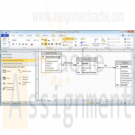
Hot Water (HW) Spas Crows Foot ERD
$15.00Create a complete ERD in Crow’s Foot notation that can be implemented in the relational model using the following description of operations. Hot Water (HW) is a small start-up company that sells spas. HW does not carry any stock. A few spas are set up in a simple warehouse so customers can see some of the models available, but any products sold must be ordered at the time of the sale. • HW can get spas from several different manufacturers. • Each manufacturer produces one or more different brands of spas. • Each and every brand is produced by only one manufacturer. • Every brand has one or more models. • Every model is produced as part of a brand. For example, Iguana Bay Spas is a manufacturer that produces Big Blue Iguana spas, a premium-level brand, and Lazy Lizard spas, an entry-level brand. The Big Blue Iguana brand offers several models, including the BBI-6, an 81-jet spa with two 6-hp motors, and the BBI-10, a 102-jet spa with three 6-hp motors. • Every manufacturer is identified by a manufacturer code. The company name, address, area code, phone number, and account number are kept in the system for every manufacturer. • For each brand, the brand name and brand level (premium, mid-level, or entry-level) are kept in the system. • For each model, the model number, number of jets, number of motors, number of horsepower per motor, suggested retail price, HW retail price, dry weight, water capacity, and seating capacity must be kept in the system. In addition, for this problem, use Excel to make a “Components of the ERM” table similar to table 4.4 on page 134. Learn More -

GetWell Inc MS Access Database
$15.00GetWell, Inc. is a leading pharmaceutical organization. The organization wants to store all its customer and order details in an MS Access database. You need to perform the following tasks:
Create a database called GetWell.
Create two tables, Customer and OrderDetails, with the following information:
Customer
FieldName Type Size
CustomerID Text 5
CustomerName Text 25
CustomerAge Text 3
CustomerAddress Text 30
CustomerID will be the primary key in the Customer table.
OrderDetails
FieldName Type Size
OrderNumber Text 5
CustomerID Text 5
OrderDate Date/Time
OrderValue Number
Discount Number
OrderNumber will be the primary key in the OrderDetails table.Enter following records in the Customer table:
Learn More
CustomerID CustomerName CustomerAge CustomerAddress
C0001 Debbie Howe 28 123, Florida
C0002 Ed Young 33 New York, 234
C0003 Tom Wilkins 47 A-234 New Jersey
C0004 XXXXX XXXXXe 76XXXXXSuite
C0005 Ken Burton 52XXXXXNorth
C0006 XXXXX XXXXX 65 53, N. Dakota
C0007 XXXXX XXXXX 29 655, Wisconsin
C0008 John Barrett 55 2234, Georgia
Enter the following records in the Order table:
OrderNumber CustomerID OrderDate OrderValue Discount
O1207 C0003 10/1/2004 10500 10
O2222 C0008 4/30/2005 26790 15
O2657 C0001 11/23/2004 50000 15
O3412 C0003 2/3/2004 222 0
O4532 C0004 3/27/2005 12320 10
O4578 C0006 6/8/2004 1110 5
O4778 C0001 7/8/2004 3378 5
O5732 C0007 4/15/2005 98700 15
Write SQL statements for the database you have created to do each of the following:
Display details of all the customers whose age is greater than 45 years.
Display the names and addresses of all the customers who have placed orders with a value more than $10,000.
Display the names of customers along with the values of the orders they placed after March 01, 2005.
Create an INSTEAD OF trigger to display the message "You cannot update Order Value", if a user tries to update the OrderValue field in the Order table.
Perform all the above activities using MS Access. -
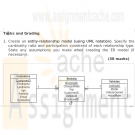
Sopwith Coach Hire Database and ERD
$15.00Guidelines
The work consists of the design, implementation and population of a small database system that will form the basis of the report to be handed in.
You will be expected to work on your own and should submit deliverables arrived at independently using your own knowledge and effort.
Sopwith Coach Hire Database
Sopwith Coach Hire Ltd is a leading provider of coach and minibus hire in West London. The company was founded in 1982 and it has continued with steady expansion over the past 30 years. The company operates a fleet of vehicles which are available for hire. The majority of the company’s clients are local schools within West London that use the vehicles for school trips. . However, vehicles can also be booked for private functions.
The Director has requested the creation of a database system to assist in the more effective and efficient running of the company. The Director has provided the following description of the current system.
System OverviewCustomers
A vehicle can be booked by customers and a customer can book many vehicles.
Details of customers need to be recorded, which include name, address, email address and contact number.
Vehicles
The company has a large number of vehicles that range from a standard six seater MPV to a 49 seater coach.
Table 1 (appendix A) lists the company’s fleet of vehicles. The company has more than one model type of vehicle. The hourly rate for hiring each vehicle is also displayed in this table.
Booking
The company wishes to record details of all bookings made by their customers. This will include detailed information of each trip a vehicle is booked for.
Each customer is charged the hourly rate for each vehicle (you may assume that no discounts are given for long term hire).
Employees
The company employs a large number of employees and details of each member of staff need to be recorded. These details include name, address, home telephone number, date of birth, gender, job description, national insurance number and current annual salary. The majority of employees are drivers but the company also has a number of administrative staff that takes the bookings.
The database must be able to handle driver assignments. Each hired vehicle requires a driver. A second driver is required in the following situations; (1) If the driver cannot have a break of not less than 45 minutes after each 4.5 hours of driving, or (2) if the driver cannot have a 10 hour break after driving a maximum of 9 hours driving in a day.
Licence
Each driver must have a valid driver’s licence with no penalty points. Details of each driver’s licence needs to be recorded. This will include the licence number and the expiry date.
In order to drive a small passenger-carrying vehicle with nine to 16 passenger seats, a driver must have a D1 code on their licence. To drive any bus/coach with more than eight passengers, a driver must have a D code. Some drivers have only a D1 code and are therefore only allowed to drive the minibuses. Other drivers have both codes on their licences and can be used for any of the company’s hired vehicles.
Tests
The company operates a program that involves random alcohol or drug testing. Any driver may be required to take either the alcohol or drug test or both.
Sopwith Coach Hire Ltd is required to keep a complete record of all test types, dates and results for each driver.
C Tasks and Grading
1. Create an entity-relationship model (using UML notation). Specify the cardinality ratio and participation constraint of each relationship type. State any assumptions you make when creating the ER model (if necessary). (30 marks)
2. Produce a Data Dictionary for the ER diagram in part (1). (25 marks)
3. Implement the set of relational tables created in part (2) using Oracle.
You must include your CREATE TABLE statements in the report. (10 marks)
4. Populate the tables with relevant data.
A screen shot of the populated tables must be included in the report. (10 marks)
5. A full discussion of the constraints used, covering the three types: entity, referential and column. Explain why you used them and how they ensure that the integrity and consistency of your data is maintained. (10 marks)
6. Write 3 queries to demonstrate that your database meets the data requirements of the system. You have to work out what you consider to be the best 3 queries that demonstrate the database meets the data requirements of the system. In your queries you are expected to use a range of SQL queries. ***
A screen shot of the query output must be included in the report.
*** If you produce 3 queries that are simply SELECT * FROM, then you will receive no marks. (15 marks)
Learn More -
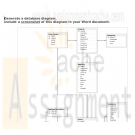
Northwind Database SQL Queries
$10.00Install the Northwind Database into the environment. Click here to install the database.
Note that this link does link to the SQL Server 2000 Sample Databases, but after downloading it, the ZIP file can be extracted and contained inside the package as a file named "instnwnd.sql." This file can be opened and executed inside of Microsoft SQL Server Management Studio.Task #2
Generate a database diagram.
Include a screenshot of this diagram in your Word document.Task #3
Learn More
Write SELECT statements for the following questions:
For each of these statements, include a screenshot of the SQL. Make sure to include the statement execution, including the resulting data.
1. Display all columns and all rows from the Employees table.
9 rows returned
2. Display the regionid, regiondescription for all rows in the Regions table.
4 rows returned
3. Modify query 2 so that the column headings are as follows:
"ID" and "Description"
4 rows returned
4. Display the customer ID, customer name, and region for all customers.
91 rows returned
5. Display the customer ID, customer name, and region for all customers.
Name the columns "ID," "Name," and "Region" (respectively), and sort the data by the company name.
91 rows returned -
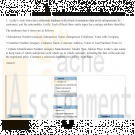
CS371 Database Design Week 5 Assignment Chapter 6 Questions
$20.00CS371 Database Design Week 5 Assignment Chapter 6 Questions
Learn More
Chapter 6 Exercises 1 page 154: Use MySQL Workbench to construct the relational diagram for this database.
Chapter 6 Exercises 2 page 154: Use MySQL Workbench to construct the relational diagram for this database.
Chapter 6 Exercise 5 page 155: Submit responses in Word Doc format.
You may submit a single word doc with SQL queries and your models pasted in – OR – submit separate files including PDFs of your models and a word doc with your queries.
Chapter 6 Exercise 1 page 154: Use MySQL Workbench to construct the relational diagram for this database:
1. Leslie’s Auto Sales has a relational database with which it maintains data on its salespersons, its customers, and the automobiles it sells. Each of these three entity types has a unique attribute identifier.
The attributes that it stores are as follows:
• Salesperson Number (unique), Salesperson Name, Salesperson Telephone, Years with Company
• Customer Number (unique), Customer Name, Customer Address, Value of Last Purchase From Us
• Vehicle Identification Number (unique), Manufacturer, Model, Year, Sticker Price Leslie’s also wants to keep track of which salesperson sold
which car to which customer, including the date of the sale and the negotiated price. Construct a relational database for Leslie’s Auto Sales.
Answer:
Chapter 6 Exercise 2 page 154: Use MySQL Workbench to construct the relational diagram for this database.
2. The State of New York certifies firefighters throughout the state and must keep track of all of them, as well as of the state’s fire departments. Each fire department has a unique department number, a name that also identifies its locale (city, county, etc.), the year it was established, and its main telephone number. Each certified firefighter has a unique firefighter number, a name, year of certification, home
telephone number, and a rank (firefighter, fire lieutenant, fire captain, etc.) The state wants to record the fire department for which each firefighter currently works and each firefighter’s supervisor. Supervisors are always higher-ranking certified firefighters.
Construct a relational database for New York’s fire departments and firefighters.
Answer:
Chapter 6 Exercise 5 page 155: Submit responses in Word Doc format.
5. In the General Hardware Corp. database of Figure 6.1, what would happen if:
a. The delete rule between the CUSTOMER and CUSTOMER EMPLOYEE relations is restrict and an attempt is made to delete the record for customer 2198 in the CUSTOMER relation?
b. The delete rule between the CUSTOMER and CUSTOMER EMPLOYEE relations is cascade and an attempt is made to delete the record for customer 2198 in the CUSTOMER relation?
c. The delete rule between the CUSTOMER and CUSTOMER EMPLOYEE relations is set to null and an attempt is made to delete the record for customer 2198 in the CUSTOMER relation?
d. The delete rule between the CUSTOMER and CUSTOMER EMPLOYEE relations is restrict and an attempt is made to delete the record for employee 33779 of customer 2198 in the CUSTOMER EMPLOYEE relation?
e. The delete rule between the CUSTOMER and CUSTOMER EMPLOYEE relations is cascade and an attempt is made to delete the record for employee 33779 of customer 2198 in the CUSTOMER EMPLOYEE relation?
f. The delete rule between the CUSTOMER and CUSTOMER EMPLOYEE relations is set-to-null and an attempt is made to delete the record for employee 33779 of customer 2198 in the CUSTOMER EMPLOYEE relation?
Answer: -
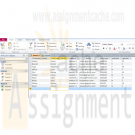
INF322 DATABASE MANAGEMENT Week 5 Final Project Customer Service Database
$20.00INF322 DATABASE MANAGEMENT Week 5 Final Project Customer Service Database
Learn More
The Final Project consists of building a customer service database to be submitted by the final day of the course.
Focus of the Project
1. Use the Access database you created in Week 3: Customer Service Database
2. Output 3 queries using SQL code and not the standard access view:
A query on all contacts in the customers table showing first name, last name, address, e-mail address and three additional fields from the table.
An update query that changes one or more customer records but not all records.
A delete query that removes one or more customer records but not all records.
3. Using SQL commands, add a new field called Birthday to the Customers table. Populate some of the fields with data.
4. Report on Customers in Database showing Names, State, and Phone Numbers.
5. Create a report showing contact name and birthdays. Do not show records without a birthday.
6. Analyze the data populated in the Database to show referential integrity. This includes a statement showing what the affected tables in each dataset are and how they are impacted in the case of an addition of data or a deletion of data.
7. All data and screen shots should be included in a Word document with a brief explanation of the actions you performed. -
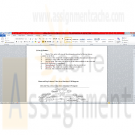
CMIS 320 Project 1 Mom and Pop Johnson video store ERD
$20.00CMIS 320 Project 1 Mom and Pop Johnson video store ERD
This project allows students to demonstrate their skills in the area of designing relational databases to satisfy specific business rules and requirements. The deliverables for this project include an Entity Relationship Diagram and detailed documentation describing the database design and structure.
Project 1 Details:
In this project you will be provided a set of specifications to create an entity-relationship diagram and design accompanying table layout using sound relational modeling concepts and practices. The relationships between the entities and the attributes for the entities will be identified and described. This database will provide the foundation for the follow-on project. The following paragraphs provide the background and summary of the business requirements.
You are a database consultant with Ace Software, Inc. and have been assigned to develop a database for the Mom and Pop Johnson video store in town. Mom and Pop have been keeping their records of videos and DVDs purchased from distributors and rented to customers in stacks of invoices and piles of rental forms for years. They have finally decided to automate their record keeping with a relational database.
You sit down with Mom and Pop to discuss their business, and watch their operation for about a week. You discover quickly that a video and a DVD are both copies of a movie kept in a separate plastic case that is rented out. They have several copies of each movie they rent; therefore there are several videos and DVDs for each movie title. You learn that in their inventory they have several thousand videos and DVDs, which they get wholesale from about a half dozen distributors. The video and DVD prices to them are based on the quantity of their shipment and the past business they have done with each company.
The price of a DVD for a movie might be different than the price of a video for the same movie, even from the same distributor. Each distributor provides different types of movies (e.g., suspense, horror, mystery, comedy, etc.). A single distributor may provide several different types of movies in both video and DVD format. It is possible to obtain the same movie from multiple distributors, and at different wholesale prices.
Each video and DVD has a unique identification number that Mom and Pop assign in their inventory, in addition to the distributor's serial number for the item. Each movie also has a unique identification number Mom and Pop assign in addition to the title, and any movie IDs the distributors use in their electronic catalogs. Distributors provide electronic catalogs to Mom and Pop and the information from these catalogs must be included in the database.
Mom and Pop need to record when a video or DVD is rented, when a video or DVD is returned, and all customer charges such as late and damaged fees, failure to rewind fees, and taxes. They need a report of which videos are returned late because there are standard and late charges. On occasion there are discount prices for certain movies or types of movies. Customers want to rent movies based on actors or actresses, running length, type of movie, rating, year released, the director, and the academy awards won (by the movie, the actors, the actresses and/or the directors). Customers also want to know how many videos they have rented in the last month, year, and so forth. Mom and Pop need to keep only basic information on customers in their database, such as name, address, telephone numbers, etc.
There must be no limit to the number of video and/or DVD copies of a movie that Mom and Pop can have in their inventory. Video/DVD ID numbers, movie ID numbers, and distributor ID numbers for videos, DVDs, and movies are all different. Also, each movie must be able to have an unlimited number of actors, actresses, directors, and academy awards (i.e., Oscars). Other types of awards (e.g., Golden Globe, People's Choice, etc.) are not of interest for this application. The rental of equipment, sale of videos, DVDs, popcorn, etc., is not to be kept in the database.
Using this information, you should:
1. Determine and list your entities. Then describe fully the relationships between entities via pairs of sentences that indicate the two components of the total relationship in both directions between the entities. Relationships may be unary, binary, or ternary with respect to entities. You should not have any many-to-many relationships.
2. Begin the database logical design by identifying the entities, relationships between entities, and entities' attributes as we have done in this course. Use the same entity/relationship diagram (ERD) notation as used in class for entities, attributes, and relationships. Sketch your ERD by hand or a drawing program (e.g., Visio, PPT, SQL Modeler …) on one single 8-1/2" x 11" page (8-1/2" x 14" maximum), labeled "Mom and Pop Johnson Video Store Database E/R Diagram." Your ERD should not have any many-to-many relationships between entities. Make sure that all relationships between entities are one-to-many to facilitate the construction of relational database tables.
3. Complete the logical database design and start the physical database design by creating metadata (i.e. documentation) that describes the table(s) created from each entity and the column(s) created from each attribute in the ERD. Attributes should be self-describing. Particular attention will be given to the proper specification of all primary key (via "PK") and foreign key (via "FK") columns in the table layouts. These should match your ERD exactly. Begin these descriptions on a page labeled "Proposed Database Tables and Columns based on E/R Diagram." All tables must be 3rd Normal Form. Indicate any and all assumptions that were made.
4. Make sure your work is neat and legible.
Submissions:
1. You should submit a well-organized Word document that includes your entity list, ERD, and database design description. This document should also include all assumptions and your lesson learned during your project.
2. Submit in your WebTycho portfolio in the Project 1 area before the due date. Please contact the instructor before the due date if you have any questions or concerns.
Learn More -

CMIS 320 Project 2 Mom and Pop Johnson Video Store Oracle Database
$20.00CMIS 320 Project 2 Mom and Pop Johnson Video Store Oracle database
Learn More
In this project you will perform the physical design and implementation using SQL Data Definition Language (DDL) and proceed with populating the Mom and Pop Johnson Video Store database via Data Manipulation Language (DML) SQL commands. The ERD and detailed documentation from Project 1 will be supplied for your entry point for those who need it.
Project 2 Details:
1. Create Oracle database tables using SQL Data Definition Language (DDL) for each table listed in Project 1. Make sure that entity and referential integrity are enforced by declaring a primary key for each table (these may be composite keys) and declaring all appropriate foreign keys. Your CREATE TABLE statements must show integrity constraints, as appropriate, for NOT NULL, UNIQUE, PRIMARY KEY, FOREIGN KEY, REFERENCES, and CHECK constraints. Be sure to save your script used to create these tables as yournameproject2step1.sql. You should test your script to make sure it runs without error.
2. Provide two examples of SQL DML (i.e., "INSERT") commands that fail different table integrity constraints you set up in one of your table. Explain why the statements fail. Be sure to save your script used to as yournameproject2step2.sql. You can include comments in the SQL script describing why the insert statements failed.
3. Populate each of your tables with at least five valid rows of data each and show the SQL you used. Populate other tables in your database, as necessary, to satisfy referential integrity. Be sure to save your script used to create these records as yournameproject2step3.sql. You should test your script to make sure it runs without error.
4. Write SQL to perform the following queries and updates. Be sure to save your script used to create these records as yournameproject2step4.sql. You should test your script to make sure it runs without error:
a. Retrieve all of your customers' names, account numbers, and addresses (street and zip code only), sorted by account number.
b. Retrieve all of the videos rented in the last 30 days and sort in chronological rental date order.
c. Produce a list of your distributors and all their information sorted in order by company name.
d. Update customer names to change their maiden names to married names. You can choose which records to update.
e. Delete customers from the database. You can choose which records to delete.
Submissions:
1. You should submit your four SQL scripts satisfying each of the steps above. Feel free to compress the files using WinZip and save as YournameProject2.zip.
2. Submit in your portfolio in the Project 2 area before the due date. Please contact the instructor before the due date if you have any questions or concerns. -
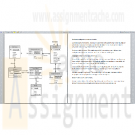
I.C.U Blinds Database Design ERD
$20.00I.C.U Blinds Database Design
A customer goes to the store to buy blinds. This customer is served by one salesperson in a department. This salesperson can have many customers. An installer is scheduled to measure the customer's house for blinds. The installer can have many customers but each customer is served by only one installer. When a customer buys a blind, an invoice is created for the transaction. Installers and sales people report to a manager. A manager may manage many employees.
Based upon a visit to the store and interviews with several store employees, consider the following:
Customer data must be stored including name, address, email address, and phone number. Sales person and installer data must be stored including name, address, phone number, hire date, and manager ID. Manager information is similar but the database must store information about the employees they manage. Each employee may also have dependents eligible for the company-provided health coverage. Information to be stored about dependents includes name and date of birth. Each blind has a SKU, price, and description associated with it. Each invoice may have multiple blinds on it. Invoices include date purchased, item quantity, and calculated fields such as item subtotals (qty * price), and grand total.You have been asked to design a database for “I.C.U Blinds” based upon your expertise in databases.
CHOOSE ONE OF THE FOLLOWING (AND ONLY ONE)
Option #1 (Rock)
Draw the dependency diagrams which step through the normalization process (1NF, 2NF, and 3NF). Denormalize as needed and show your final dependency diagram. If you do denormalize, explain the reasoning behind each case. Please follow the formatting guidelines as per the normalization homework assignment we did. What you should turn in, is similar to the Chapter 5 assignment.Option #2 (Hard Place)
Break down the scenario into the component relationships. For each relationship, write the associated one liner, and the 4 sentences. Combine these relationships and in Visio, draw the ERD associated with your solution. Be sure to note all attributes, PKs, FKs, cardinality, optional and mandatory relationships, strong/weak relationships and entities. What you should turn in, is very similar to the Chapter 4 assignments.Tips and tricks
Learn More
Carefully consider each question and do not be afraid to add attributes – some will be needed (e.g. primary and foreign keys), some need to be inferred – (e.g. purchase date for the invoice), and some will be calculated (e.g. totals). As we have learned in class, remember in your answers that good solutions take into account the trade-offs between number of tables, the amount of data redundancy, and data to be entered for each transaction.




